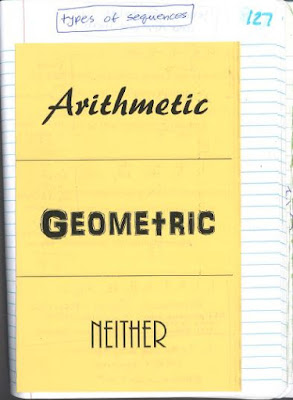https://risesa.wordpress.com/tag/foxtrot/
 Back to sequences.
Back to sequences.I start the lesson at the end of the last unit test. As they finish the test, students take a sequences review sheet that reminds them of the preconcepts they had learned in Algebra One.
We start the actual lesson with a frayer diagram on sequences.
Then we defined each of the types of sequences with this foldable. Inside the foldable you will find the details.
I did include a "neither" category because Fibonacci sequences are very cool and the sequence of perfect squares is pretty common yet is neither arithmetic or geometric.
Next we reviewed the arithmetic and geometric sequence formulas. I do like to spend a little time showing how each formula relates to example. I like them to see how the arithmetic involves the repeated addition of the common difference (thus appears as multiplication in the formula) and the geometric involves repeated multiplication of the common ratio (thus appears as a power in the formula). I use this foldable to summarize the formulas.
Inside there are examples.
I like my precalculus students to apply these formulas in constructing sequences also. These problems involve creating a system of equations using the general formulas. The geometric one is interesting because you solve that system using division, not a typical operation used in solving systems of equations.
Finally if I have time (we do have an 82 minute block) I like to do a quick comparison of explicit versus recursive rules. The focus in this course is the explicit rules but recursive rules are useful, especially in computer programming. These pages show my overview.
I like to use our TI 84 graphing calculators to experience the recursive rules too. We go through an arithmetic sequence - first we type in the first term (let's use 8) and press enter. This will give you the first term and establishes the first term in your calculator. Then we type the rule (let's say d = 5, so they would type +5). That establishes the rule in your calculator. And it will give us the second term. With those two steps the recursive formula has been programmed into your calculator. Now you can use this recursive program to generate additional terms. Each time you press enter you will get successive terms starting with the third term.
For homework, I give my students examples in our textbook to complete.
Here is the folder on box.com that contains the ISN masters for both sequences & series.









No comments:
Post a Comment